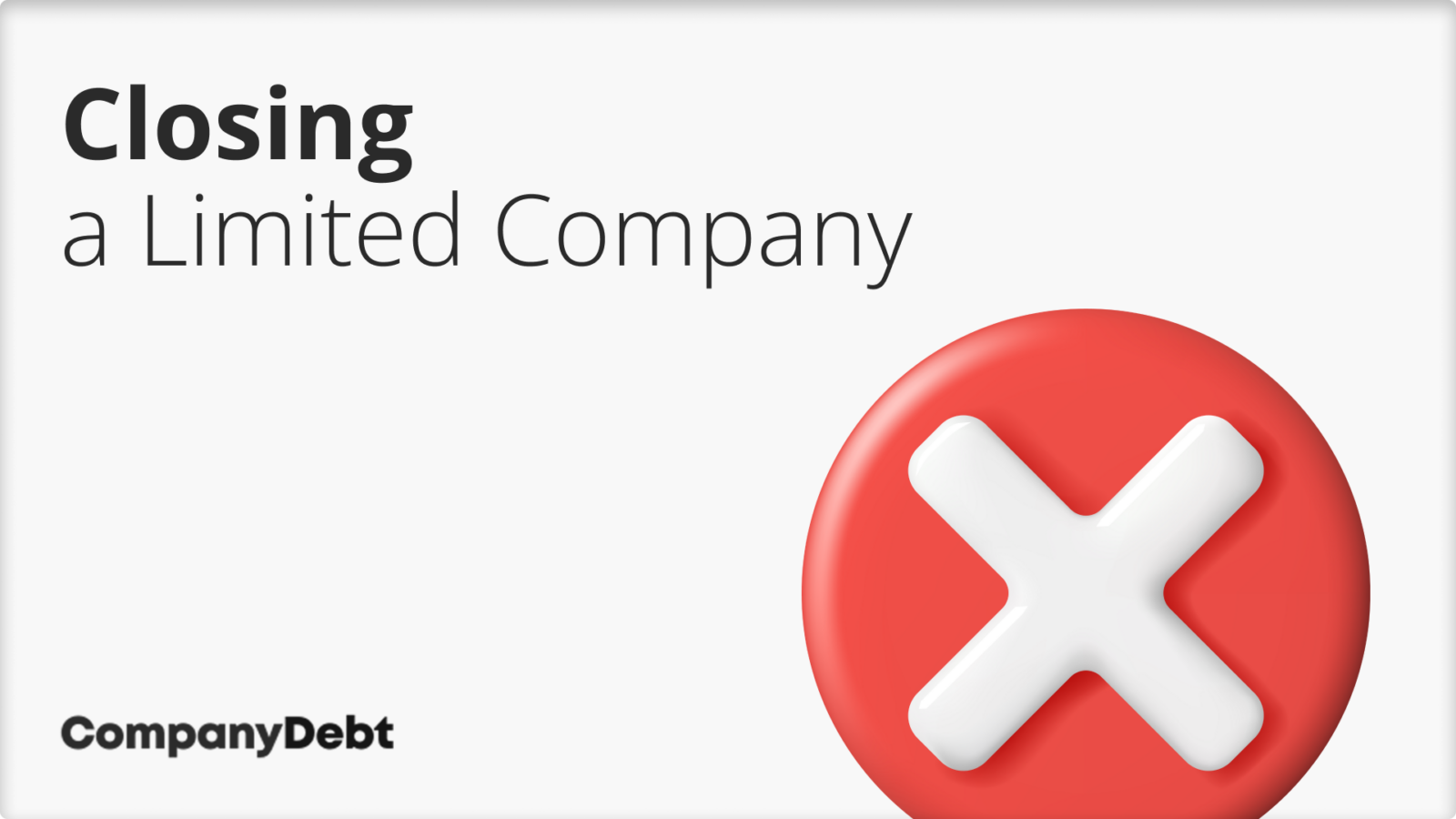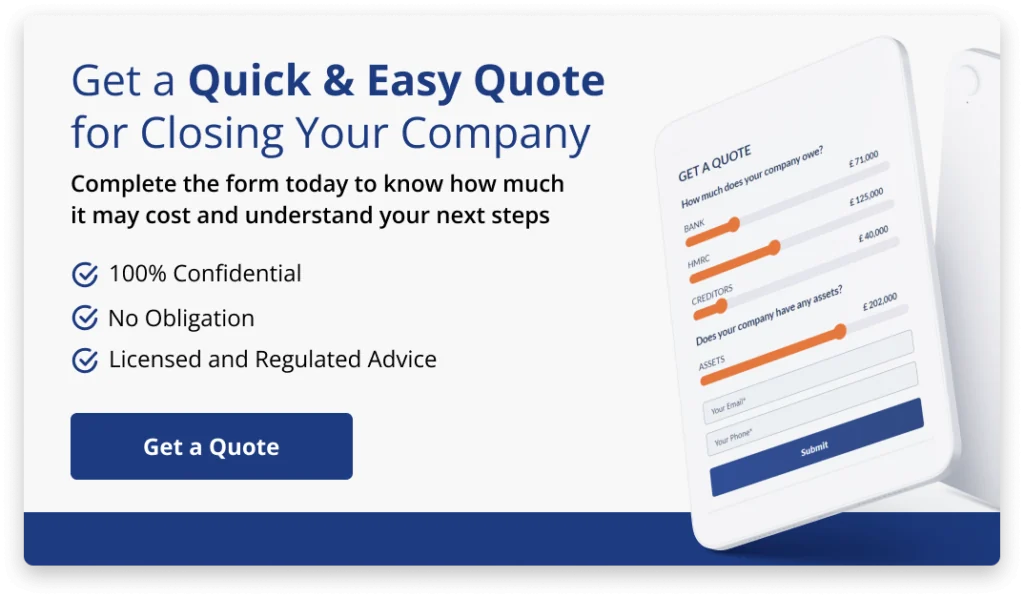Closing Down a Limited Company: A Guide
Whether you are closing your company due to retirement, a change in business direction, or any other reason, it is crucial to understand the proper way to wind down operations and settle all outstanding affairs. Failure to follow the correct process can result in personal liability for directors and potential penalties.
This guide will cover the necessary actions, from settling debts to notifying relevant authorities, dealing with assets and shareholdings, and finally striking the company off the register at Companies House.
- How to Close Down a Limited Company
- What are the Options for Closing a Limited Company?
- Voluntary Strike Off
- Members’ Voluntary Liquidation
- Creditors’ Voluntary Liquidation
- Compulsory Liquidation
- How Long Does it Take to Close a Company?
- How Much Does it Cost to Close a Limited Company?
- What Permissions do I Need to Close my Company?
- How to Close a Limited Company That Never Traded
- Do I Need to Notify HMRC if I Want to Close a Limited Company?
- How to Make a Company Dormant instead of Closing it
- Do I need to tell HMRC my company has been closed if it never traded?
- How Company Debt Can Help
- Closing a Limited Company FAQs
How to Close Down a Limited Company
To close a company in the UK, you’ll need to choose one of three approaches: strike off, an MVL or a CVL (voluntary liquidation).
- For a solvent business, directors can opt for voluntary strike off by applying to Companies House. This process involves settling all business debts, notifying relevant parties, and submitting the DS01 form.
- If the solvent company has assets, a member’s voluntary liquidation (MVL) offers a tax-efficient means of selling these and formally closing.
- If your company is insolvent, directors should opt for a creditors’ voluntary liquidation (CVL). An insolvency practitioner oversees the process, which includes selling assets to pay creditors and concluding the company’s affairs.
Each route has specific legal requirements and implications, so seeking professional advice is essential.
I’ll go into each option in detail below.

What are the Options for Closing a Limited Company?
Voluntary Strike Off
Striking off a limited company from the Companies Register is a straightforward and cost-effective method for closing a solvent company that is no longer trading. This method is especially popular among small business owners who are retiring or shifting to new ventures.
Eligibility for Voluntary Strike Off
Before applying for a strike off, ensure your company meets the following criteria: it hasn’t traded in the last three months, it has no outstanding debts (including to HMRC, suppliers, and employees), and it is not involved in any legal proceedings. Once eligibility is confirmed, you can apply to Companies House either online or by post, accompanied by a nominal fee and necessary details such as names of directors and shareholders.
Gazette Notification and Objection Period
After your application is submitted, Companies House will publish a notice in the Gazette, the official public record of the UK. This notice serves to inform the public and potential creditors of the impending strike off. Following this publication, there is a mandatory two-month waiting period for any objections to be raised and resolved.
Completion of Voluntary Strike Off
If no objections are received during the waiting period, Companies House will formally strike off the company. You will receive a notice of dissolution confirming that your company has been officially closed and legally ceases to exist, completing the process.
Members’ Voluntary Liquidation
Members’ Voluntary Liquidation (MVL) is a formal procedure used to close a solvent limited company, which is particularly beneficial for companies with assets exceeding £25,000. This method ensures that all debts are paid and can offer significant tax advantages for distributions made during the process.
Criteria and Initiation of MVL
To qualify for an MVL, a company must be solvent and able to settle all its debts within 12 months. The process begins with the company’s shareholders passing a resolution for voluntary liquidation. Directors must then prepare and swear a Declaration of Solvency, which includes a detailed statement of the company’s assets and liabilities.
Appointment of an Insolvency Practitioner
Once the resolution is passed, a licensed insolvency practitioner (IP) must be appointed to oversee the liquidation. The IP’s duties include selling the company’s assets and distributing the proceeds to shareholders in a tax-efficient manner. This role is crucial for ensuring that the liquidation complies with legal standards and is conducted efficiently.
Completion and Dissolution
The liquidator is responsible for formal notifications to creditors, allowing them to submit any outstanding claims. This ensures all financial obligations are transparently and lawfully addressed. After settling all claims and distributing the assets, the liquidator will apply for the company’s dissolution at Companies House, formally concluding the MVL process and removing the company from the register.
Creditors’ Voluntary Liquidation
Creditors’ Voluntary Liquidation (CVL) is a formal procedure used to close a company that is insolvent, providing an alternative to compulsory liquidation initiated by a court order. This method allows company directors to take proactive steps in managing the dissolution process, preserving some control and potentially safeguarding their reputations.
Initiation and Resolution for CVL
The CVL process starts with a formal resolution to wind up the company, which must be approved by at least 75% of the shareholders during a general meeting. This resolution is essential for initiating the formal liquidation process and is a mandatory step to proceed with a CVL.
Appointment of an Insolvency Practitioner
Following the resolution, a licensed insolvency practitioner (IP) is appointed to act as the liquidator. The IP’s responsibilities are crucial; they oversee the closure of the company, the valuation and sale of its assets, and the distribution of proceeds to creditors according to legal priorities.
Notice Publication and Asset Liquidation
After the IP’s appointment, it is mandatory to publish a notice of the liquidation in The Gazette, officially informing creditors, suppliers, and other stakeholders of the company’s status. The liquidator then proceeds to liquidate the company’s assets. The funds raised are used to pay creditors, starting with secured creditors, followed by unsecured creditors, ensuring adherence to the legal hierarchy of claims.
Dissolution and Conclusion of CVL
Once all debts have been settled and any remaining legal obligations fulfilled, the liquidator applies for the company’s dissolution. This final step removes the company from the Companies House register, officially marking the end of the business and concluding the CVL process.
>>Read our full article on the Advantages and Disadvantages of a Creditors’ Voluntary Liquidation
Compulsory Liquidation
Compulsory liquidation is a severe form of liquidation that is typically initiated by creditors or HM Revenue & Customs (HMRC) when a company fails to pay its debts. This process forces a company to cease operations and dissolve officially.
Initiation of Compulsory Liquidation
The process begins when a creditor files a winding-up petition in court. HMRC often initiates compulsory liquidations due to unpaid taxes, but other creditors such as suppliers or lenders may also file a petition if they believe the company is insolvent. If the court finds the company unable to pay its debts, it will issue a winding-up order.
Appointment of the Official Receiver
Once a winding-up order is issued, an official receiver is appointed. The official receiver’s role is to oversee the liquidation of the company’s assets, settle debts with creditors, and distribute any remaining assets according to legal priorities. This includes managing the sale of the company’s assets and ensuring that proceeds are distributed fairly among creditors.
Consequences and Closure
The completion of compulsory liquidation results in the company’s formal dissolution, effectively ending its legal existence. This process has significant implications for the company’s directors, who may face investigations into their conduct during the period leading up to the liquidation. Compulsory liquidation can have lasting impacts on the directors’ future business activities and personal finances.
How Long Does it Take to Close a Company?
Closing a company in the UK varies in duration; a Members’ Voluntary Liquidation (MVL) for solvent companies typically concludes within 6 to 12 months.
Voluntary liquidation for insolvent companies and striking off a company from the Companies House register can take around 3 to 6 months.
Compulsory liquidation, initiated by creditors or HMRC, is usually more prolonged, often extending beyond 12 months due to its complexity.
How Much Does it Cost to Close a Limited Company?
The cost of closing a limited company in the UK varies widely based on the method chosen and the complexity of the process:
- Striking off a company directly through Companies House is the least expensive option: It costs £8 to apply online, or £10 for a paper application.
- Members’ Voluntary Liquidation (MVL) tends to be more costly, with fees typically starting from £1,500 to £3,000, but can increase significantly depending on the size and complexity of the company.
- Compulsory liquidation costs can vary greatly. While the petitioning creditor usually covers the court fees, the overall expenses related to the liquidation process could be higher, depending on the assets and liabilities involved.
- Creditors’ Voluntary Liquidation (CVL) also varies, with professional fees generally starting from £4,000 upwards, influenced by the company’s size, number of creditors, and asset disposition.
These figures are indicative and can fluctuate based on specific circumstances and the professionals involved.
What Permissions do I Need to Close my Company?
To close your company in the UK, the permissions required depend on the method of closure:
- Striking off: You must have the agreement of all company directors and inform any shareholders, creditors, and employees. The company should not have traded or sold off any stock in the last three months.
- Members’ Voluntary Liquidation (MVL): Requires a declaration of solvency from the directors, affirming the company can pay its debts within 12 months. Shareholders must also approve the liquidation, typically requiring a 75% majority vote in favour.
- Creditors’ Voluntary Liquidation (CVL): This method requires a vote by the shareholders to agree on liquidation, followed by a meeting with creditors to appoint a liquidator.
- Compulsory Liquidation: Initiated by creditors through a court order, so the company itself does not need to obtain permission, but must respond to legal actions taken by creditors.
How to Close a Limited Company That Never Traded
Strike-off, also called dissolution, is the simplest and most cost-effective way to close a limited company that has never traded. This is a relatively simple process, but there are a few things you need to do first.
- Pass a resolution to strike off the company. This must be done at a general meeting of shareholders. All shareholders must agree to the resolution.
- Complete and submit Form DS01 to Companies House. This form must be signed by all of the company’s directors.
- Pay a filing fee to Companies House. The current fee is £10.
- Once Companies House has processed your application, your company will be struck off the register and will cease to exist.
If you are unsure whether your company is eligible for voluntary strike-off or you need help completing the form, you can seek professional advice from an accountant or solicitor.
Do I Need to Notify HMRC if I Want to Close a Limited Company?
You will need to notify HMRC if you decide to dissolve (Strike Off) a limited company.
If you are closing a limited company via MVL or CVL, the appointed Insolvency Practitioner (IP) typically has the responsibility of notifying HM Revenue and Customs (HMRC) as part of the liquidation process.
How to Make a Company Dormant instead of Closing it
To make your company dormant, ensure that all clients and employees are aware that you are ceasing trading and that any agreements or contracts are to be terminated.
Then you can follow these steps:
- Notify HMRC that your company is dormant. You can do this online or by phone.
- File your dormant company accounts with Companies House. You can do this online or by post.
- Submit a confirmation statement to Companies House each year. You can do this online or by post.
Do I need to tell HMRC my company has been closed if it never traded?
Yes, if your company has been closed and it never traded, you still need to inform HM Revenue and Customs (HMRC) about the closure. Even if the company had no business activities or tax liabilities, HMRC should be notified to ensure their records are updated, and no further tax obligations or filings are expected from the company.

How Company Debt Can Help
Closing your company can feel daunting, but you don’t have to face it alone. At Company Debt, our experienced insolvency practitioners offer the support and guidance you need to navigate the process smoothly.
Why Choose Us?
- Expert Advice: Get direct support from experts who understand the ins and outs of company closure.
- Personalised Help: Receive tailored solutions that fit your unique situation.
- Ease Your Burden: Let us handle the complexities, reducing your stress.
- Confidential Service: Your privacy is our priority. We handle your case with discretion.
Closing a Limited Company FAQs
Can I close my company if it has outstanding debts?
Yes, via a process called creditors voluntary liquidation, which is where the directors voluntarily opt to liquidate. The use of an insolvency practitioner is mandatory to ensure fair play for creditors.
What steps are involved in closing a company voluntarily?
When closing a company voluntarily, directors must call a general meeting to pass a resolution for winding up, appoint a liquidator to settle affairs, and notify Companies House within 15 days of the resolution.
What should be considered before initiating a company closure?
Before initiating a company closure, it’s important to evaluate outstanding debts, notify all stakeholders, ensure all company taxes and reports are up to date, and assess the implications for employees.
What is the difference between Company Closure and Company Dissolution?
Company closure often refers to the process of ceasing operations and winding up a company, whereas company dissolution is the final step where the company is formally removed from the Companies House register.
How can one reinstate a company after closure?
To reinstate a company after closure, an application must be made to the court for a restoration order. This requires submitting evidence explaining why the company was dissolved and how you meet the criteria for restoration, as well as settling any outstanding debts or filing requirements.
What are the legal requirements for notifying creditors about a company closure?
When closing a company, directors must inform all creditors about the intended closure. This is usually done by sending a written notice and, if the company is being voluntarily wound up, advertising the resolution to wind up in The Gazette.
What are the consequences of not following proper procedures during company closure?
Failure to follow proper procedures during company closure can result in legal and financial penalties for directors, including personal liability for company debts, fines, or disqualification from serving as a director in the future.







